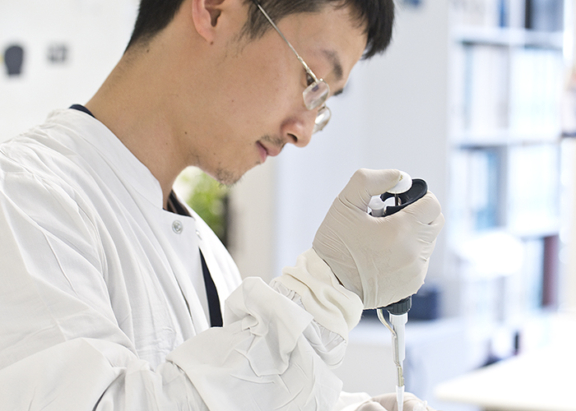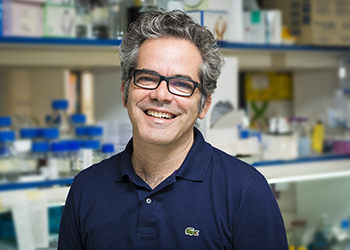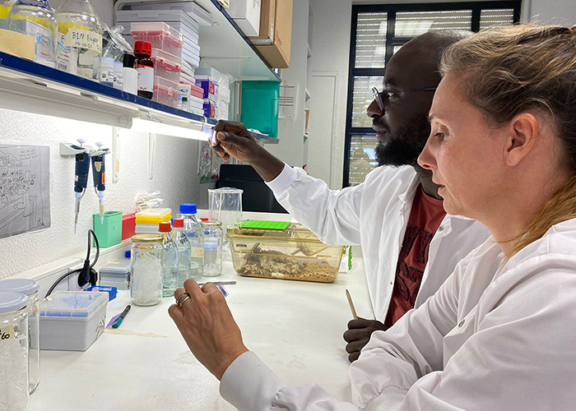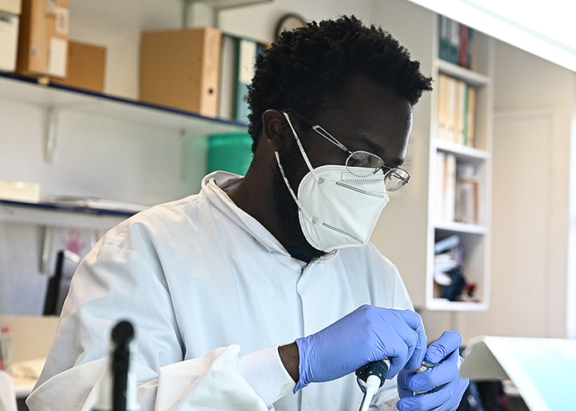
Inflammation
Miguel Soares
Immunity evolved in multicellular organisms to limit the potential negative impact resulting from continuous exposure to microbes. Innate and adaptive components of the immune system are endowed with the capacity to sense and target pathogenic microorganisms for containment, destruction or expulsion as the means to preserve organismal homeostasis and fitness. Resistance to infection refers to the output of these immune functions.
Multicellular organisms also evolved another defense strategy that preserves organismal homeostasis and fitness without exerting a direct negative impact on microorganisms. This defense strategy, referred to as disease tolerance, relies on evolutionarily conserved stress and damage responses that limit the extent of metabolic dysfunction and damage imposed on parenchyma tissues, either directly by pathogenic microorganisms or indirectly by immune-driven resistance mechanisms.
The overall aim of the Inflammation Laboratory is to identify and characterize these stress and damage responses which confer tissue damage control and establish disease tolerance to infection.
The central hypothesis tested is that a functional interplay between immune-driven resistance mechanisms, and stress and damage responses acting in parenchyma tissues, exists to limit, counter and repair the pathogenic effects of infection.
Understanding the cellular and molecular mechanisms governing this network of interactions and responses should be transformative in our understanding of host-microbe interactions, with direct impact on the treatment of infectious diseases.
Original Scientific contributions:
- Identified that renal iron-heme metabolism in the kidney is essential to counter the pathogenesis of severe malaria (Proc. Natl. Acad. Sci. USA. 2019).
- Identified a cross-regulatory network between iron and glucose metabolism that is essential to establish disease tolerance to sepsis (Cell 2017).
- Uncovered a symbiotic interaction whereby bacterial components of the gut microbiota elicit an antibody response that counters malaria transmission (Cell, 2014).
- Discovered that regulation of iron metabolism and establishes disease tolerance to systemic infections (Cell Host & Microbe, 2012).
- Discovered a central molecular mechanism via which sickle hemoglobin establishes disease tolerance to malaria (Cell, 2011).
- Revealed that the stress responsive enzyme heme oxygenase-1 supports the survival of an infected host independently of its pathogen load, providing the first mechanistic basis for the establishment of disease tolerance to malaria (Nature Medicine, 2007 and Proc. Natl. Acad. Sci. USA. 2009) and to sepsis (Science TM, 2010; Science, 2012).
- Discovered that the gasotransmitter carbon monoxide (CO), generated via heme catabolism by heme oxygnease-1, acts therapeutically in a range of immune-mediated inflammatory conditions, including the rejection of transplanted organs (J. Immunology, 2001, Nature Medicine, 2003), arteriosclerosis (Nature Medicine, 2003), ischemia & reperfusion injury (FASEB Journal. 2004), autoimmune neuroinflammation (J. Clinical Investigation 2007) and severe malaria (Nature Medicine, 2007).
Our current body of work was sparked to a large extent by the original demonstration, with the late Fritz H. Bach at Harvard Medical School, that the gasotransmitter carbon monoxide(CO) acts in a cytoprotective (J. Exp. Med., 2001) and immunoregulatory (Nature Medicine, 2000) manner, providing a mechanistic basis for how transplanted organs prevent their own rejection (Nature Medicine, 1998).
The Research group host sabbaticals under the “International Sabbatical Programme – Cátedras de Oeiras”.
Member

Projects
Biliverdin reductase A (BVRA) is a multifunctional protein highly expressed by macrophages.
Its enzymatic activity acts downstream of heme catabolism, converting biliverdin into bilirubin. Both end-products are physiologic ligands of the nuclear Aryl hydrocarbon receptor, an immunoregulatory component of the transcriptional stress and damage control network that promotes disease tolerance to infection.
Bilitolerance is aimed to address whether BVRA promotes disease tolerance.
This translational study is designed to expand our pre-clinical data in assessing the relative efficiency of targeting α-gal glycans to prevent Plasmodium infection and malaria transmission, for possible inclusion in future malaria vaccines.
The study consists of calibrating the protective effect of α-gal-specific antibodies against well-established protective antibodies recognizing Plasmodium falciparum circumsporozoite protein (PfCSP).
The primary outcomes of this study are to determine:
Intermediate outputs include:
Anorexia of infection is a component of sickness behavior that impacts on the outcome of infectious diseases.
The mechanisms regulating this metabolic response remain elusive. We found that anorexia of infection is associated with induction of ferritin expression in the liver.
This master regulator of iron metabolism induces the expression of G6Pase, sustaining hepatic glucose production and maintaining blood glucose within upper and lower threshold levels compatible with host survival.
Glucoinfect addresses how this metabolic response operates to establish disease tolerance to viral, bacterial and protozoan infections.
We are investigating a neurometabolic response regulated at the level of the hypothalamus and acting downstream via the sympathetic nervous system that appears to be essential to establish disease tolerance.
This neurometabolic response regulates:
i) lipolysis in white adipose tissue,
ii) thermogenesis in brown adipose tissue,
iii) glycogenolysis and gluconeogenesis in the liver and
iv) glucagon and insulin release from α and β cells of the pancreas, respectively.
Neurotolerance is aimed at characterizing how this neurometabolic response contributes to the establishment of disease tolerance to viral bacterial or protozoan infections.
Stress and damage responses evolved from ancestral forms of life, where these provided organismal adaptation to environmental variation. These variations, often associated with infection, are sensed and reacted upon by a transcriptional stress and damage response network, encompassing the nuclear factor (erythroid-derived 2)-like 2 (NRF2).
This master transcriptional regulator of oxidative stress responses induces the expression of target genes that are essential to establish disease tolerance to malaria and sepsis.
Tolerancenetwork is aimed at identifying and characterizing NRF2-effector genes regulating glucose/energy metabolism and establishing disease tolerance to infection.
Immune-driven resistance mechanisms can lead to immunopathology and compromise disease tolerance. Regulatory T cells (TREG) restrain immune-driven resistance mechanisms from operating beyond the protective capacity afforded by the transcriptional stress and damage response network.
We found that regulation of iron metabolism impacts on TREG lineage maintenance and function.
Tregtolerance is aimed at elucidating the mechanisms via which this occurs, towards the establishment of disease tolerance.
Publications
- Qian Wu, Euclides Sacomboio, Lara Valente de Souza, Rui Martins, Jamil Kitoko, Sılvia Cardoso, Temitope W. Ademolue, Tiago Paixão, Jaakko Lehtima, Ana Figueiredo, Caren Norden, Pierre-Louis Tharaux, Guenter Weiss, Fudi Wang, Susana Ramos and Miguel P. Soares (2023) Renal control of life-threatening malarial anemia. Cell Reports 42 (2)
- Susana Ramos, Temitope W. Ademolue, Elisa Jentho, Qian Wu, Joel Guerra, Rui Martins, Gil Pires, Sebastian Weis, Ana Rita Carlos, Inês Mahú, Elsa Seixas, Denise Duarte, Fabienne Rajas, Sílvia Cardoso, António G.G. Sousa, Jingtao Lilue, Tiago Paixão, Gilles Mithieux, Fátima Nogueira, Miguel P. Soares, (2022) A Hypometabolic Defense Strategy Against Malaria. Cell Metabolism
- Elisa Jentho, Cristian Ruiz-Moreno, Boris Novakovic, Ioannis Kourtzelis, Wout. L. Megchelenbrink, Rui Martins, Triantafyllos Chavakis, Miguel P. Soares, Lydia Kalafati, Joel Guerra, Franziska Roestel, Peter Bohm, Maren Godmann, Tatyana Grinenko, Anne Eugster, Martina Beretta, Leo A. B. Joosten, Mihai G. Netea, Michael Bauer, Hendrik G. Stunnenberg and Sebastian Weis (2021) Trained innate immunity, long-lasting epigenetic modulation, and skewed myelopoiesis by Heme. PNAS 118 (42)
- Singh S., Thompson J.A., Yilmaz B., Li H., Weis S., Sobral D., Truglio M., Da Silva F.A., Aguiar S., Carlos A.R., Rebelo S., Cardoso S., Gjini E., Nuñez G., Soares M.P. (2021) Loss of α-gal during primate evolution enhanced antibody-effector function and resistance to bacterial sepsis. Cell Host & Microbe 29 (3):347-361
- Ramos S., Carlos A.R., Sundaram S., Jeney V., Ribeiro A., Gozzelino R., Bank C., Gjini E., Braza F., Martins R., Ademolue T.W., Blankenhaus B., Gouveia Z., Faísca P., Trujillo D., Cardoso S., Rebelo S., del Barrio L., Zarjou A., Bolisetty S., Agarwal A. & Soares M.P. (2019) Renal control of disease tolerance to malaria. Proceedings of the National Academy of Sciences 116 (12) :5681-5686
- Weis S., Carlos A.R:, Moita M.R., Singh S., Blankenhaus B., Cardoso S., Larsen R., Rebelo S., Schäuble S., Del Barrio L., Mithieux G., Rajas F., Lindig S., Bauer M., Soares M.P. (2017) Metabolic adaptation establishes disease tolerance to sepsis.. Cell 169 (7):1263–1275.e14
- Yilmaz B., Portugal S, Tran T.T., Gozzelino R., Ramos S., Gomes J., Regalado A., Cowan P.J., d’Apice A.J.F., Chong A.S., Doumbo O.K., Traore B., Crompton P.D., Silveira H., Soares M.P. (2014) Gut microbiota elicits a protective immune response against malaria transmission.. Cell 159 (6):1277-1289
- Medzhitov, R., Schneider, D., Soares M.P. (2012) Disease tolerance as a host defense strategy.. Science 335 (6071):936-941
- Ferreira A., Marguti I. Bechmann I., Chora A., Palha N.R., Rebelo S., Henri A., Beuzard Y., Soares M.P. (2011) Sickle hemoglobin confers tolerance to plasmodium infection.. Cell 145(3):398-409
- Larsen R., Gozzelino R., Jeney V., Tokaji L., Bozza F.A., Japiassú A.M., Bonaparte D., Cavalcante M.M., Chora A., Ferreira A., marguti I., Cardoso S., Sepúlveda N., Smith A., Soares M.P. (2010) A central role for free heme in the pathogenesis of severe sepsis. . Sci Transl Med. 2 (51):51ra71
- Pamplona, A., Ferreira, A., Balla, J., Jeney, V., Balla, G., Epiphanio, S., Chora, A., Rodrigues, C.D., Cunha-Rodrigues, M., Portugal, S., Soares, M.P.* Mota, M.M*. *Equal contribution. (2007) Heme oxygenase-1 and carbon monoxide suppress the pathogenesis of experimental cerebral malaria. . Nat Med. 13 (6):703-710
- Otterbein, L.E., Haga, M., Zuckerbraun, B.Z., Liu, F., Ruiping Song, R., Usheva, A., Stachulak, C.H., Bodyak, N., Smith, N.R., Cismadia, E., Akamatsu, Y., Flavell R., Billiar, T.R., Tzeng, E., Bach, F.H., Choi, A.M.K., Soares, M.P. (2003) Carbon monoxide suppresses arteriosclerotic lesions associated with chronic graft rejection and with balloon injury.. Nat Med. 9 (2):183-190
- Brouard S., Otterbein L., Anrather J., Tobiasch E., Bach F.H., Choi A.M.K., Soares, M.P. (2000) Carbon monoxide generated by heme oxygenase-1 suppresses endothelial cell apoptosis.. J Exp Med. 192(7):1015-1026
- Otterbein L., Bach F.H., Alam J., Soares, M.P., Lu H.T., Wysk M., Davis R.J., Flavell R., Choi A. M. (2000) Carbon monoxide has anti-inflammatory effects involving the mitogen-activated protein kinase pathway.. Nat Med. 6 (4):422-428
- Soares, M.P., Lin Y., Anrather, J., Csizmadia, E., Takigami, K, Sato, K., Grey S.T., Colvin, R.B., Choi, A.M., Poss, K.D and Bach, F.H. (1998) Expression of heme-oxygenase-1 (HO-1) can determine cardiac xenograft survival.. Nat Med. 4(9):1073-1077



